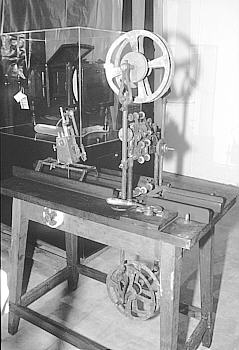
A LITTLE PRE-HISTORY
From their inception in the late 1800s, the movies have taken on many shapes and sizes, not just on the screen but also a variety of film gauges were used in the early days. Thomas Edison is generally credited with the creation of the 35mm format that became the norm. Edison and many others had also done work with 70mm and other film widths. The 35mm standard pioneered by Edison has remained almost unchanged. With a nearly square aspect ratio of 1.33:1, later altered to 1.37:1 in the early 1930s with the addition of sound on film, this frame shape is still seen on television, 8mm and 16mm film. Experiments with 56mm, 65mm, 70mm and other film widths were done throughout the late 1920s and early 1930s. A few films were produced in these larger formats but they quickly died as the depression made the expense to re-equip theatres with new projectors and screens an economic impossibility.
 |
Film gauge: 51mm (inside rollers). Aperture: 37mm W x 20mm H
Courtesy John Hiller:
Smithsonian Institution, National Museum of American History, Photographic History Collection

Edwin S. Porter's The Great Train Robbery (1903)
Filmed in the 1.33:1 aspect ratio, which would remain virtually unchanged for half a century.


The Bat Whispers (1930)
Photographed in both 35mm and 70mm, as seen in the title frames above. Joseph Schenk would later be involved in Todd-AO, and some of the cameras he used in 1930 would be converted for Todd-AO.
Perhaps the studios offered too much, too soon, for exhibitors. As noted on this poster for The Bat Whispers sound was still a big deal, and a huge financial investment.
The rise in popularity of television is credited with inciting the move to the widescreen systems that flourished throughout the 50s, 60s, and 70s. This is only partially true. In the early 1950s, studios did begin to compose their movies so that the top and bottom of the picture could be chopped off and a wider screen would show the center of the old 1.37:1 frame. The aspect ratio used by the various studios varied from about 1.5:1 up to the common 1.85:1. But the real reason for the birth of a multitude of widescreen and large format systems was the 1952 opening of a movie made in a process that had its roots in a World War II aerial gunnery trainer. This Is Cinerama shook the industry to the core. The public and reviewers loved it. Its giant screen filled with three oversized 35mm images and an incredible new sound system called Stereophonic were a marvel to behold, and the studios immediately rushed to find something that could do what Cinerama did.
Visitors are encouraged to carry with them a sense of the history of the motion picture industry in the United States. While the old studio system is much denigrated, it had some very positive aspects also. As you wander through the different wings of The American WideScreen Museum you will continually find that the systems that were developed supposedly to fight the threat of television actually dated back two decades when television was a term found only in science fiction movies. The studio heads and their technical staffs strived for ever better photographic and sound production and exhibition methods. Wide screens, large format film, and multichannel sound came to fruition in the 1950's but the seed had been planted decades before by the studio autocrats. The great depression and the second world war presented barriers and a few new technical advancements for many of the systems that we celebrate here. We hope you enjoy touring the museum as much as we have in assembling its contents.The WideScreen Museum is dedicated to the inventors of the great widescreen systems and to the film crews that created the memorable films we've been privileged to enjoy.
If the word Anamorphic is Greek to you then click here.
Step Into The Foyer
